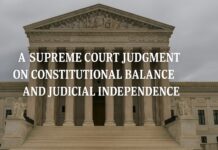LT. COL. P.K. CHOUDHARY AND ORS. (THE RESPONDENTS) were commissioned into various Corps/streams of the Indian Army after they successfully passed out from the Indian military Academy/Officers Training Academy. The initial allocation of the respondents to different Corps was based on parameters prescribed for that purpose depending inter alia upon the number of actual vacancies in Arms, Arms Support or Services, operational commitments and requirements arising from new raisings. Merit of the candidates, the need for an equal distribution of vacancies applying what is described as ’Black Method’ and the individual choice expressed by the cadets were also some of the major factors that were taken into consideration while making allocations.
It is common ground that there was no challenge to the allocation of cadets to Arms, Arms Support or Services at any point of time. It is also not in dispute that four out of the five Respondents viz. Lt. Col. P.K. Choudhary, Lt. Col. G.S. Dhillon, Lt. Col.A.K. Pandey and Lt. Col. R.M.S. Pundir had opted for commission into Army Service Corps (AMS) and none of them had opted either for Combat Arms or Arms Support. Similarly, Lt. Col. Ajay Chawla-Respondent No. 5 in this appeal had given Army Service Corps as one of the options of his choice. The respondents were accordingly allocated and have served in their respective Corps and Raisings as Lt. Colonels, which rank they held at the time of filing Original Application No. 430 of 2012 in the Tribunal and continue to do so at present.
Post-Kargil War, the Government of India constituted what was called Kargil Review Committee which was followed by a Committee headed by ShriAjay Vikram Singh with a view to explore ways and means for enhancing the operational preparedness of the India Army in its fighting capabilities especially in Combat Arms. The Committee comprised, apart from Shri Ajay Vikram Singh, a representative of the Ministry of Defence (Finance), Director General (MP&PS),Army Headquarters, Joint Secretary (G), Ministry of Defence and several senior officers of the Indian Army including Adjutant General, Army Headquarters, Chief of Personnel, Naval Headquarters and Air Officer-in-Charge Personnel, Air Headquarters. The Committee appears to have conducted extensive deliberations and submitted a report suggesting both short term and long term measures that were, in its opinion, necessary for restructuring of the Officers’ Cadre of the Army. The Committee recommended that although the report primarily focused on the restructuring of the Officers’ Cadre of the Army, the same will be applicable in an equal measure to the Navy and the Air Force who could work out their service specific requirements including additional vacancies required at various ranks on operational/ functional grounds. We may point out that one of the significant recommendations which the Committee made to the Government was about the lowering of age profile of the Officers in the Indian Army. For instance, instead of existing age profile of 41-42 years for Colonels the Committee recommended lowering of the age profile to 36-37 years. Similarly, for Brigadiers the Committee recommended an age profile of 44-45 years instead of 50-51 years at present. The age of Major Generals was profiled at 51-52 years as against 54-55 years under the existing system. The age of Lieutenant Generals was, according to the Report, profiled at 55-56 years instead of 56-57 years under the existing system. The lowering of age profile was considered by the Committee to be necessary for enhancing the optimal combat effectiveness of the Army. To achieve that objective, the Committee recommended creation of 1484 additional vacancies in the ranks of Colonel out of which 400 vacancies were to be released in the first year while the another 300 vacancies were to be released in the second year after an annual review. The implementation of the recommendations had to be progressive, coordinated and corroborated for the desired results to flow for the benefit of the Army.
The appellants’ case is that the recommendations made by the AVS Committee were accepted by the Government and 1484 additional vacancies in the rank of Colonel were sanctioned with a view to lowering the age of Commanding Officers in combat and combat support arms resulting in an increased upward mobility of the Officers Cadre. The additional vacancies were to be released in two phases spread over a period of four years from 2004 to 2008.
It is common ground that in the first phase, the Government released 750 vacancies, out of the newly created 1484 vacancies, in the rank of Colonel by an order dated 21st December, 2004. These vacancies were sanctioned by upgradation of appointments in the rank of Lt. Colonel to Colonel in a phased manner spread over a period of two years i.e. 2004-2005 and were distributed amongst Arms, Arms Support and Services on a pro-rata basis. The result was that not only did the additional vacancies become available to Arms and Arms Support but the same were allocated even to those serving in Services like ASC, AOC and EME. Thus far, there was no difficulty as officers serving in Arms, Arms Support and Services in different Corps of the Army were all equally benefitted by the fresh creation. The problem started with the release of another 734 vacancies in the second phase by an order dated 3rd November, 2008. These additional vacancies were sanctioned by effecting upgradation in a phased manner spread over a period of five years and were directed to be allocated on what is described as “Command Exit Model” which the Government of India claimed was in consonance with the functional and operational requirements of the Army.
Aggrieved by the denial of pro-rata share in the 2nd tranche of the additional vacancies released by the Government, officers like the respondents who are serving in the Arms Support and Service Corps of the Army, filed Original Applications No. 430 of 2012, 77 of 2014 and 147 of 2015 before the Armed Forces Tribunal, Principal Bench, New Delhi to challenge the Government’s policy dated 29th January, 2009 on the ground that the same was discriminatory, arbitrary and violative of fundamental rights guaranteed to them. They prayed for quashing of the policy besides a direction to the Government of India to allocate vacancies in the rank of Colonel to each Corps on pro rata basis and convene Special Boards for promotion of the eligible Officers to such posts. The respondents also prayed for a direction to the Union of India to grant to them ’Ante-Date’ seniority and arrears of pay and allowances from the date an officer immediately junior to the said respondents in the rank of Lt. Colonel serving in Arms and Arms Support Units was granted his promotion.
The Appellant-Union of India contested the claim made by the respondents and argued that the recommendations made by the AVS Committee were limited to Officers serving in the Arms and Arms Support and specifically left out services from their purview. It was also argued that the Government of India had approved and accepted the recommendations made by the a VS Committee and sanctioned 1484 additional vacancies specially created for allocation on “Command Exit Model” to Arms and Arms Support Units for whose benefit such new vacancies were created. The allegation that the policy formulated by the Government or the “Command Exit Model” for allocation of vacancies was discriminatory and/or arbitrary was stoutly denied.
By its order dated 2nd March, 2015 the Armed Forces Tribunal, Principal Bench, New Delhi has allowed the Original Application(s) filed by the respondents and quashed Government of India policy dated 21st January, 2009 with the direction that the Government of India shall create supernumerary posts so that the additional vacancies so created are allocated to all the three streams on a pro rata basis.
Against the judgement of the Tribunal appeal was filed under Section 31 of the Armed Forces Tribunal Act, 2007 in the Supreme Court. The Supreme Court allowed the appeals while setting aside the order passed by the Tribunal and directed that the appellants shall create 141 additional posts of Colonel to be allocated to ’Combat Support’ stream being utilized by appointing officers who were eligible for promotions against the same as in the year 2009 over a period of 5 years till 2014.
The operative part of the judgement read as under :
A careful reading of report especially paras 20 and 36 extracted above leaves no manner of doubt that the Committee emphasized the need for bringing down the age profile of Unit Commanders in Operational Units only. The Committee recognized Armoured Corps, Infantry, Mechanised Infantry, Artillery, AD, Engineers and signals as operational formations leaving out ASC, AOC, EME and other Minor Corps. The report clearly suggests that the additional creation of 1484 vacancies in the rank of Colonels did not take into account vacancies for Colonels in ASC, AOC, EME and other Minor Corps. As a matter of fact, the report very clearly states that the age profile of such Service formations for Minor Corps could be higher than that required to operate in the combat conditions. We have, in that view, no hesitation in holding that there was neither any recommendation regarding reduction in age profile of Unit Commanders in ASC, AOC and EME nor was there any recommendation for creation of additional vacancies to benefit officers serving in those formations. The argument that the Committee had recommended creation of 1484 vacancies for the benefit of Officers serving in all formations is, therefore, without any basis and is accordingly rejected. Additional vacancies were specifically recommended for the operational formations mentioned above and were meant to be allocated to those formations depending upon the recommended tenure of the Commissioning Officers in those formations and the possibility of re-command. Inasmuch as ASC, AOC, EME Officers did not benefit from the creation of additional vacancies, there was neither any violation of the recommendations made by the AV Singh Committee nor was the distribution of the additional vacancies discriminatory as alleged. Question No. 1 is answered accordingly. ***********************************
That 750 vacancies comprising the first tranche released by the Government were allocated on a pro rata basis contrary to the recommendations and the decision of the Government cannot be and has not been denied. The question is whether the said allocation would by itself undo either the recommendations made by the Committee or the decision taken by the Government to allocate the newly created vacancies on “Command Exit Model” principle. Our answer to that question is in the negative. Just because allocation of vacancies in the first tranche was made by the Army Headquarters ignoring the recommendations of the Committee and the Government decision cannot possibly result in the reversal of the Government decision nor can it negate the Command Exit Model. So also, simply because the earlier allocation was not reversed as the officers had picked up their ranks does not affect the binding nature of the Government decision that the allocation should be on “Command Exit Model”.
***********************************
Having said that, the adjustment/set off of the vacancies so allocated against the entitlement of the arms and arms support in the second tranche does not appear to be justified. If the Army Headquarters committed a mistake in allocating vacancies on a pro rata basis contrary to the recommendations and decision of the Government, any such error cannot adversely affect officers serving in arms and arms support who may have been entitled to a higher number of vacancies in the second tranche but who were deprived of such allocation on account of the error in the previous allocation made on pro rata basis. We pointed out this aspect to Mr. Maninder Singh and asked him to take instructions whether the Government was willing to correct the mistake arising out of such adjustment/set off or justify the same on any juristic principle. To the credit of Mr. Maninder Singh we must mention that he has on instructions fairly conceded that the second tranche of 734 vacancies could and ought to have been allocated on “Command Exit Model” principle without taking into consideration the excess, if any, allocated to the arms and the arms support on pro rata basis in the first tranche. Mr. Maninder Singh on that basis also took instructions to file before us a statement showing the number of vacancies that would have ordinary fallen to the share of arms support corps if the second tranche of 734 vacancies were allocated without making any adjustment of vacancies previously allocated. We shall turn to that statement when we take-up Question No. 3 for discussion, but, before we do so we need to conclude Question No. 2 by holding that the recommendations of the AVS Committee regarding allocation of additional vacancies on “Command Exit Model” basis had been accepted by the Government and that allocation of the first tranche of 750 vacancies by the Army Headquarters on pro rata basis contrary to the Government decision and the recommendations of the Committee did not affect the validity of the decision nor did it amount to reversal of the said decision or its dilution in any manner. Question No. 2 is answered accordingly.
***********************************
The allocation of 734 vacancies, comprising the second tranche, when made on standalone basis, (without any adjustment of the excess allocated in the first tranche) is the only right method for allocation in our opinion. The excess allocated in the first tranche, against which officers who may not have otherwise picked up the higher rank were promoted, cannot possibly deny the rightful due to those who would be entitled to claim promotion against the vacancies in the second tranche. The respondents are, therefore, right in arguing that the second tranche should be allocated on a standalone basis.
***********************************
We must, at the outset, say that command tenure is a policy matter on which the scope of judicial review is extremely limited. What should be the tenure of a commanding officer for Arms or Arms Support is for defence experts or for the Government to determine on expert advice having regard to a variety of factors. It is neither necessary nor proper for any court or tribunal to sit in judgement over any such decision leave alone, substitute the same by its own decision. If the Government has upon consideration of the nature of duties and the need for battle preparedness of the force has taken a decision to prescribe a tenure of upto four years for officers serving in Arms Support, it will be difficult to fault the same in the absence of any patent perversity in any such decision especially when no breach of any fundamental or other right of any one complaining against the prescription of such a tenure is demonstrated. No such infirmity has been pointed out to us in the case at hand. Having said that, we must add to the credit of the appellant and their counsel that the question of a shorter tenure was considered by them favourably at our suggestion only to avoid any frustration or disgruntlement among officers serving in arms support. Mr. Maninder Singh, on instructions, submitted that the tenure of commanding officers in arms support shall for purpose of creation/allocation of vacancies, be taken as three years instead of four years.
***********************************
To the extent of a deficit of 141 vacancies in the cadres of Colonel to Arms Support (Artillery, AAD, Engineers and signals) an unfair distribution of the vacancies from out of the second tranche were released by the Government. It is, at the same time, heartening to note that the Government have not taken an adversial stand nor have the Government opposed the undoing of the injustice caused to officers who were eligible for promotion in the year 2009 but were not promoted on account of lesser number of vacancies allocated to Arms Support. On the contrary Mr. Maninder Singh appearing for the Union submitted that the Government would do anything to prevent any frustration or disenchantment among the officers serving in the army by creating 141 additional posts in the cadre of Colonel for allocation to Arms Support so that the same are utilized appropriately for promoting officers eligible for such promotion. Mr. Singh, however, suggested a method of utilization of the posts so created over a period of ten years to avoid an inequitable distribution and also to minimize the scope of any of the batches getting any undue benefit at the cost of other batches. Mr. Maninder Singh has also highlighted problems of implementation like managing of the cadre in case the utilization of the additional vacancies is to be done within a shorter time frame of say five years. Having given our anxious consideration to the submissions made at the bar, we are of the view that the additional 141 vacancies which ought to have been allocated to Arms Support in the year 2009 were unfairly denied to them. It has taken the aggrieved officers and legal process considerable time to have the said unfairness and injustice reversed by creating of additional vacancies. These vacancies shall, therefore, be taken to have been created as in the year 2009 and promotions against the same made from out of officers who were eligible for such promotion as in that year. It is not in dispute that the Selection Board that deals which such promotions has empanelled officers based on their inter se merit and suitability. All that is, therefore, required is to operate the said merit list for utilization of the additional vacancies now being created. In other words, the additional creation shall, for all intents and purposes, be deemed to have been available for being filled-up as in the year 2009 but to be actually filled-up in 5 years between 2009- 2014. Those who pick-up the next rank against the said vacancies shall have the benefit of retrospective seniority as is the practice in the Army but such seniority on appointment shallnot entitle them to the benefit of higher pay-scale or arrears against the post to which they are promoted. In other words, financial benefits shall accrue to officers promoted pursuant to the creation of additional vacancies only with effect from the date they are actually promoted. Question No. 3 is answered accordingly.
***********************************
The question is whether the creation of such additional vacancies would ensure the benefit for officers serving in the services on account of what such officers claim to be ’one cadre’ principle. The contention urged on behalf of the respondents was that no matter some of the respondents belong to services, they are a part of the same cadre and were, therefore, entitled to a pro rata share out of the newly created vacancies at par with those serving in Arms and Arms Support. Reliance in support of that contention was placed upon a circular dated 12th November, 1987 issued by the Military Secretary’s Branch. There is, in our view, no merit in the submission urged on behalf of the respondents that officers allocated to Arms and Arms Support and Services comprise a single cadre for purposes of promotion. We say so because transferability which is one of the essential attributes of posts comprising a single cadre is absent in the case of service officers on the one hand and those serving in Arms and Arms Support on the other. This Court has in several decisions examined what would constitute a common cadre, and held that merely because the incumbents of two posts are placed in the same scale of pay does not determine whether such posts constitute a cadre (see) K.S. Srinivasan v. Union of India (UOI) [AIR 1958 SC 419]. In Chakradhar Paswan v. State of Bihar & Ors. [supra], this Court declared that the term cadre has a definite legal connotation in service jurisprudence and that interchangeability of the incumbents is one of the attributes of a cadre just as similarity of the responsibilities and pay may be indicative of all posts being in the same cadre.
***********************************
Applying the above test to the case at hand we have no hesitation in holding that officers serving in the Service stream of the Army do not constitute a single cadre with officers serving in Arms and Arms Support, no matter they may all be drawing the same salary, holding the same rank, wearing the same uniform and serving the same employer with similar service benefits. The true position is that allocation of officers to different Arms and Services puts them in distinct cadres, with the result that those comprising a particular cadre will have his or her promotional avenues available against the posts comprising that cadre alone notwithstanding the fact that the Government of India may, as a policy, attempt to ensure as far as possible that officers of a given batch pick up their ranks around the same time or within a reasonable span of their counterparts in other cadre or that the disparity in the time frame for promotion is removed by making promotions retrospective from the dates officers in the other cadre have been promoted. Reliance by the respondents upon Circular dated 12th November, 1987, is in our view misplaced. That circular, it is evident, from a reading of the same was issued in connection with the implementation of the Fourth Pay Commission to remove a certain doubt regarding the interpretation of the term “cadre” as applicable to army officers. It was in that context that the expression “cadre” has been explained in the circular by reference to the method of allocation to Arms and Services, and similarity of other conditions of service. The circular, it is evident, does not constitute a statement of law much less can the exposition of the term ’cadre’ as given therein operate as estoppel against the union. The circular it is evident is an internal communication and has been issued in a totally different context. We, therefore, have no difficulty in answering question No. 4 in the negative and holding that officers in service streams do not constitute a single cadre with those serving in Arms and Arms Support for purposes of allocation of additional vacancies created pursuant to the recommendations made to the Government by AV Singh Committee.
***********************************
Legitimate expectation as a concept has engaged the attention of this Court in several earlier decisions to which we shall presently refer. But before we do so we need only to say that the concept arises out of what may be described as a reasonable expectation of being treated in a certain way by an administrative authority even though the person who has such an expectation has no right in law to receive the benefit expected by him. Any such expectation can arise from an “express promise” or a ’consistent course of practice or procedure” which the person claiming the benefit may reasonable expect to continue. The question of redress which the person in whom the legitimate expectation arises can seek and the approach to be adopted while resolving a conflict between any such expectation, on the one hand, and a public policy in general public interest on the other, present distinct dimensions every time the plea of legitimate expectation is raised in a case.
***********************************
Coming to the case in hand, the plea of legitimate expectation does not appear to be of any assistance to the respondents for two precise reasons. Firstly, there is no real basis for the respondents to argue that the Government of India had either by representation or by any sustained course of conduct created an impression in the minds of the respondents that any additional vacancies created to the lower age profile of commanding officers serving in Combat Arms or Combat Arms Support shall also benefit those serving in the Service Streams of the Army. There is no factual basis laid by the respondents in the pleadings before the tribunal to suggest that any such impression as gathered by officers serving in the Service Streams. There is also no basis for the contention that a legitimate expectation arose in the minds of the respondents that they shall be promoted to the next rank simultaneously with the officers serving in Combat Arms or Combat Arms Support. As a matter of fact, the provisions of para (68) of the Regulations for the Army extracted earlier itself envisages the grant of promotion to officers from different streams at different points of time depending upon several factors which bring about the time lag for such considerations. Conscious of the fact that such officers serving in different streams may pick up the next rank at different points of time, the Regulations provide for grant of retrospectivity to the promotions so granted to restore inter se batch parity to such officers. There is no denying the fact that the said Regulation continues to be operative and regardless of the date when the officer is promoted, his promotion is so related back as to protect his seniority vis-à-vis his colleagues from the batch serving in other streams. Far from creating any impression or any expectation that promotions shall be simultaneous, the Regulations clearly provide for grant of retrospective effect to the promotions only with a view to restore seniority. This clearly implies that in the very nature of things the promotions could be granted to officers at different points of time and time lag could additionally be in the 0-1-2 scenario. We have, therefore, no hesitation in rejecting the contention that the legitimate expectation did arise in the factual situation before us.
***********************************
That apart, legitimate expectation as an argument cannot prevail over a policy introduced by the Government which does not suffer from any perversity, unfairness or unreasonableness or which does not violate any fundamental or other enforceable rights vested in the respondents. In the case in hand, the government has, as a matter of policy, decided to lower the age profile of officers serving in Combat Arms and Combat Arms Support pursuant to the recommendations made by the Expert Committees. We have in the earlier part of the judgement dealt with the recommendations made by the Committees and the objectives sought to be achieved by the policy decisions of the Government. There is nothing perverse, unreasonable or unfair about the policy that the age of officers serving in Combat Arms and Combat Arms Support will be lowered by creating additional vacancies to be allotted on command Exit Model. In the absence of any per versity, unreasonableness or unfairness in the policy so introduced, we see no reason to allow the argument based on legitimate expectation to unsettle orundo the policy which is otherwise laudable and intended to render the Indian Army more efficient and better equipped for combat situations. It also is not a case where no reasonable person could have taken the decision which the Government have taken as regards the need for lowering the age profile of the Commanding Officers or their exit after 2-1/2 to 3 years to occupy positions which the Government have created for the officers to occupy till they are considered for promotion to the next higher rank. All told, the arguments based on legitimate expectation has not appealed to us. We have, therefore, no difficulty in rejecting the contention based on that principle. Question No. 5 is accordingly answered in the negative. In the result, we partly allow these appeals and while setting aside the order passed by the Tribunal direct that the appellants shall create 141 additional posts of Colonel to be allocated to ’Combat Support’ stream for being utilized by appointing officers who are eligible for promotions against the same as in the year 2009 over a period of 5 years till 2014.
***********************************
Authorities relied upon : AIR 1958 SC 419, 1990 (64) Aus LJR 327.
Reference : Supreme Court. Union of India and Anr. v. Ltd. Col. P.K. Choudhary and Ors., civil appeal no. 3208 of 2015.
















